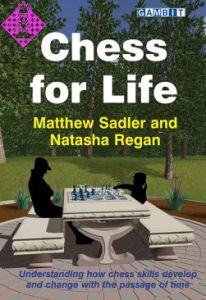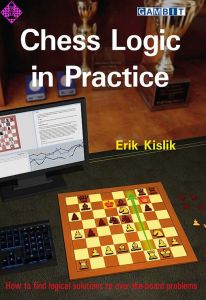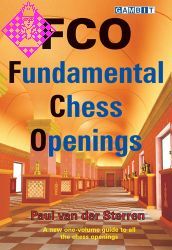Artikelnummer
LOSTEFCO
Autor
Fundamental Chess Openings
A new one-volume guide to all the chess openings
Eigenschaften
480 Seiten, kartoniert, Gambit, 1. Auflage 2009
·The perfect survival guide to the chess openings
·All openings covered
·Detailed verbal explanations of plans for both sides
·Up-to-date and featuring many tips and recommendations
·Insights into the 'character' of each opening
·Written by one of the world's foremost opening experts
The first moves of a chess game define the nature of the whole struggle, as both players stake their claim to the critical squares and start to develop their plans. It is essential to play purposefully and to avoid falling into traps or reaching a position that you don't understand.This is not a book that provides masses of variations to memorize. Paul van der Sterren instead offers a wealth of ideas and explanation, together with the basic variations of each and every opening. This knowledge will equip players to succeed in the opening up to good club level, and provide a superb grounding in opening play on which to build a more sophisticated repertoire. The strategies he explains will, unlike ever-changing chess opening theory, remain valid as long as chess is played, and so the time spent studying this book will be rewarded many times over.Introduction
In the colossal body of chess literature, no aspect of the game has been treated as extensively as the openings. In varying degrees of expertise, clarity and depth, thousands of books discuss every imaginable and unimaginable opening the game of chess has to offer. This is a process that will never stop. As long as a particular opening is being played, its variations will be worked out deeper and deeper and assessments will be modified on the basis of these new experiences. As long as chess is alive, its opening theory will also be alive and new books will be needed to document all of this new life.
This book intends to introduce the reader to this strange but fascinating world, the world of opentheory. There will be no long sequences of moves, no complicated analysis and no real attempt to keep up with the very latest developments. Instead I shall attempt to clarify the background, the geneand the development of all major openings and try to show how they are much more interconand based on the same ideas and insights than many people think. This approach makes this book a very different one from the usual opening manuals. It could perhaps be said to precede them. If it has the effect on the reader that it whets his appetite for these 'usual' opening books, or at least makes him understand them a little bit better, this book will have fulfilled its purpose.
What is Opening Theory?
Everyone who devotes even the tiniest amount of thought to his first move not only makes a start with that particular game but also with the development of opening theory. From that moment on, every new game will confront him with the starting position again and therefore with his earlier thoughts on it. Also he will sooner or later find out that millions of other players have pondered exthe same problems and, whether he wants to or not, he will to some extent start comparing his own ideas about how to start a game with theirs.
This means that opening theory arises quite naturally with the start of a game. No one can avoid it. It ends, equally naturally, with the end of a game. If we pursue our thinking about the opening position logically and systematically, while accepting only the highest possible degree of certainty as a satisfactory result, we cannot end our investigation unless we are sure we have reached either a winning or a drawn position. Seen in this light, thinking about the starting position involves a thorexamination of the middlegame and endgame as well.
It could be said then, that opening theory does not really exist, at least not as something separate from other aspects of the game. Ultimately, opening theory comprises all theory.
However, since the human brain and even the computer is still not capable of completely seeing through (and thereby destroying) chess as a whole, in practice opening theory does not end with an empty board but in positions where there is a certain consensus about how they should be assessed, for instance 'chances are equal' or 'White (or Black) has the advantage'.
Sometimes a question can be answered with total confidence. In the position after 1 e4 there is some room for discussion on how good or bad 1...g5 is (though not much), but if White continues 2 d4 here, there can be no question on the value of 2...f6 because 3 Qh5# is then mate. End of game, end of theory.
But in most cases an assessment is merely a temporary stop. The moment somebody starts quesit, the argument continues. Until the next temporary stop is reached.
And so, ever since the beginnings of chess, every single chess-player has contributed something to that gigantic construction called opening theory. This brings us to the next question.
How Much Theory Should a Player Know?
The most severe answer to this has to be 'everything', the softest 'as much as you like' and the pro-foundest 'nothing'. All three are correct.
Knowledge of opening theory is a double-edged sword. The player who knows a lot will unprofit by his knowledge, but he may also live in constant fear of meeting an opponent who knows even more. Everyone who has studied opening theory in depth will have learned that, no matter how well you do your work, there is always the possibility of having overlooked someor of not having looked deep enough. Trying to keep abreast of the latest developments, readeverything, keeping a close watch on the Internet, makes you very knowledgeable but also acutely aware of the possibility of missing something. In short, he who lives by the sword shall die by the sword.
It is therefore of the utmost importance for a chess-player to find his own personal balance beknowing too much and knowing too little. The purpose of studying opening theory should not be accumulating any set amount of knowledge, but being content with whatever knowledge one has. For someone with a natural flair for study, it may be perfect to work on openings all the time. For someone who is much less scientifically minded, even the slightest attempt to study openings may well be superfluous and even detrimental to his game.
But there is another aspect of studying opening theory to be mentioned. Anyone with even the slightest intellectual bent of mind (and which chess-player isn't?) may find getting to know a little bit about opening theory very interesting. Even without any ambition to improve your results and independent of your level of play, you may simply find the study of openings very enjoyable. You may also discover that this has absolutely nothing to do with memorizing variations or the need to occupy yourself with chess more than you want to.
This sheer fun is in my view an essential element of studying opening theory. It is my hope that this book will make some of this pleasure visible and perceptible. The book contains an overview of all major openings, how they have evolved through the years and how they are looked upon toearly in the 21 st century. I shall be just sketching the outlines and will be very concise, but perthis is precisely the way to convey the fascination that opening theory has always had for me. Opening theory has been an almost inexhaustible source of pleasure for me throughout my active chess years. I sincerely hope it may be the same for you.
| EAN | 9781906454135 |
|---|---|
| Gewicht | 850 g |
| Hersteller | Gambit |
| Breite | 17,2 cm |
| Höhe | 24,6 cm |
| Medium | Buch |
| Erscheinungsjahr | 2009 |
| Autor | Paul van der Sterren |
| Sprache | Englisch |
| Auflage | 1 |
| ISBN-13 | 9781906454135 |
| Seiten | 480 |
| Einband | kartoniert |
| Name | Gambit Publications Ltd. |
|---|---|
| Adresse | 27 Queens Pine, Bracknell Berkshire RG12 OTL Großbritannien |
| Internet | www.gambitbooks.com |
| info@gambitbooks.com |
Verantwortlicher Importeuer:
| Name | Schachversand Niggemann |
|---|---|
| Adresse | Schadowstraße 5 48163 Münster Deutschland |
| info@schachversand.de | |
| Internet | www.schachversand.de |
005 Symbols and Notation
006 Introduction
008 The First Move
009 1 d4
011 Queen's Gambit Declined
027 Slav and Semi-Slav
040 Queen's Gambit Accepted
046 Other 1 d4 d5 Openings
057 Nimzo-Indian Defence
077 Queen's Indian Defence
089 Bogo-Indian Defence
093 King's Indian Defence
121 Grunfeld Defence
140 Benoni and Benko
159 Other 1 d4 Nf6 Openings
174 Dutch Defence
185 Other 1 d4 Openings
198 Flank Openings
199 Symmetrical English
222 Reversed Sicilian
233 1 c4 Nf6 and Other English Lines
248 Reti Opening
261 Other Flank Openings
269 1 e4
272 Ruy Lopez
301 Italian Game
312 Scotch Opening
318 Four Knights Game
322 Petroff Defence
328 King's Gambit
337 Other 1 e4 e5 Openings
347 French Defence
375 Caro-Kann Defence
389 Sicilian Defence
447 Alekhine Defence
453 Pirc Defence
461 Other 1 e4 Openings
469 Index of Named Opening Lines
472 Index of Variations
006 Introduction
008 The First Move
009 1 d4
011 Queen's Gambit Declined
027 Slav and Semi-Slav
040 Queen's Gambit Accepted
046 Other 1 d4 d5 Openings
057 Nimzo-Indian Defence
077 Queen's Indian Defence
089 Bogo-Indian Defence
093 King's Indian Defence
121 Grunfeld Defence
140 Benoni and Benko
159 Other 1 d4 Nf6 Openings
174 Dutch Defence
185 Other 1 d4 Openings
198 Flank Openings
199 Symmetrical English
222 Reversed Sicilian
233 1 c4 Nf6 and Other English Lines
248 Reti Opening
261 Other Flank Openings
269 1 e4
272 Ruy Lopez
301 Italian Game
312 Scotch Opening
318 Four Knights Game
322 Petroff Defence
328 King's Gambit
337 Other 1 e4 e5 Openings
347 French Defence
375 Caro-Kann Defence
389 Sicilian Defence
447 Alekhine Defence
453 Pirc Defence
461 Other 1 e4 Openings
469 Index of Named Opening Lines
472 Index of Variations
Ich muss zugeben, dass mir beim ersten oberflächlichen Blick auf das Buch mein Geist einen kleinen Streich spielte und ich die drei fettgedruckten Buchstaben „F C O" als „ECO" wahrgenommen habe. Dieser Fauxpas irritierte mich, denn wozu den ECO-Code drucken und wie soll dabei so ein Wälzer (479 Seiten) herauskommen? Es führte also dazu, dass ein genauer Blick vonnöten war! Beim Durchblättern fällt sofort auf, dass das Buch nicht strotzt von fettgedruckten Zeilen (sprich Zügen), hingegen aber viel Text und Diagramme bieten kann. Schnell wird klar: Der holländische Großmeister und ehemalige Landesmeister Paul van der Sterren hat es sich mit diesem Werk zur Aufgabe gemacht, dass Wesen aller Eröffnungen zu erläutern. Also wurden fernab von Variantenwust die Ideen mit den Ausblick auf das Mittelspiel kombiniert. Das Material wird wie folgt aufgeteilt:
Getreu dem Anspruch des Autors im Vorwort, dass die Eröffnungsanalyse Freude bereiten soll, ist es ihm trotz aller Fülle gelungen, ein Werk zu erstellen, dass dem Suchenden die Möglichkeit gibt einen guten Einstieg in alle Eröffnungen zu erhalten und einen Blick auf das Wesentliche zu bekommen. Systeme die der Autor selbst spielt, empfand ich besser repräsentiert und die ein oder andere kritische Zugfolge wurde weggelassen - aber dafür ist ja die Spezialliteratur! Eine Übersetzung in die deutsche Sprache wird aufgrund der vielen Erläuterungen hoffentlich angestrebt.
Mit freundlicher Genehmigung
Eröffnungstheorie ist eine unendliche Geschichte. Je tiefer ein Spieler sich damit beschäftigt, desto wahrscheinlicher ist es, dass er etwas übersieht. Daher paßt die Metapher „live by the sword, die by the sword" sehr gut zu Eröffnungskenntnissen.
Laut van der Sterren sollte das Ziel des Eröffnungsstudiums nicht sein, das Gehirn mit Informationen zu überfüllen, sondern mit dem Wissen, das man hat, zufrieden zu sein. Unterschiedliche Persönlichkeiten können jedoch auch zu unterschiedlichen Herangehensweisen führen. Außer ihrer praktischen Bedeutung betont van der Sterren, dass die Eröffnungsanalyse Spaß machen soll.
Ich hatte erwartet, dass dieses Buch ähnlich Werken wie Batsford Chess Openings, Nunn's Chess Openings oder de Firmian's Modern Chess Openings sei, in denen die wichtigsten Varianten in jeder Eröffnung ohne viel Erklärung präsentiert werden.
Dieses Buch ist jedoch anders. Van der Sterren präsentiert keine lange Varianten. Stattdessen legt er den Schwerpunkt darauf, die Eröffnung zu erklären, welche Ziele beide Seiten haben und welchen schachlichen und psychologischen Charakter das weitere Spiel haben wird.
Natürlich ist der Geschmack von Spieler zu Spieler unterschiedlich und ich finde, dass van der Sterren Eröffnungen, die er selbst in seinem Eröffnungsrepertoire hat (z.B. Spanisch), besser präsentiert als einige scharfe Varianten in Sizilianisch, wo er ab und zu nicht auf dem neuesten Stand ist.
Insgesamt finde ich das Buch interessant. Es ist eine sehr gute Einführung in die Eröffnungstheorie, erklärt alles Wichtige und hilft bei der Wahl einer geeigneten Eröffnung. Der Schwerpunkt liegt darauf, die Eigenschaften und den Charakter einer Eröffnung zu erklären, da dieser sich nicht mit der Zeit verändert. Bestimmte Varianten dagegen kommen und gehen immer wieder.
Ein paar Beispiele:
Über die Leningrader Variante schreibt van der Sterren zum Schluss: "Beide Seiten brauchen eine gesunde Portion Stärke um diese Variante zu spielen und sollten keine Zweifel haben, dass ihre Strategie die richtige ist."
Zur Breyer Variante schreibt van der Sterren über die Stellung nach 1.e4 e5 2.Sf3 Sc6 3.Lb5 a6 4.La4 Sf6 5.0-0 Le7 6.Te1 b5 7.Lb3 d6 8.c3 0-0 9.h3 Sb8 10.d4 Sbd7 11.Sbd2 Lb7: "Die Chigorin Variante mit 9…Sa5 gewinnt ein Tempo, weil Weiß Lc2 ziehen muss. Der schwarze Springer steht aber nicht besonders gut auf a5. Häufig versucht Schwarz, die Position des Springers zu verbessern mittels …Sc6, …Sc4-b6 oder …c4 und …Sb7-c5. Auf d7 steht der Springer flexibler. Hier ist 12.d5 nicht gut wegen 12…c6 (oder 12…Sc5 13.Lc2 c6). Weiß muss die Bauern tauschen, wonach die schwarzen Figuren gut stehen. Eines der Argumente für die Breyer Variante ist, dass Weiß nicht ohne weiteres das übliche Manöver Sf1-g3 ausführen kann, weil der e4 Bauer gedeckt werden muss.
12.Lc2 Hier beginnt man die Logik hinter der Breyer Variante zu verstehen. Das Paradox ist, dass genau wie in der Chigorin Variante nach 9…Sa5 Weiß jetzt ein Tempo verlieren muss.
Es geht dann weiter mit 12…Te8
13.Sf1 Lf8 14.Sg3 g6, wonach van der Sterren die Hauptpläne für Weiß erklärt. Zum Beispiel, dass nach 15.a4 der Zug 15…c5 Sinn ergibt, weil nach 16.d5 c4 der schwarze Springer nach c5 ziehen will und Weiß nicht mehr b4 …cxb3 mit axb3 beantworten kann, weil der Bauer auf a4 steht.
Diese Variante ist nicht besonders lang. Es wird aber gut erklärt, was auf dem Brett los ist.
Ich kann das Buch empfehlen für Spieler, die die Eröffnungen besser verstehen wollen. Es ist auch gut dafür geeignet, eine neue Eröffnung, die man spielen möchte, kennenzulernen.
Die Nachteile sind, dass die angegebenen Varianten recht kurz sind und die laut aktueller Theorie kritische Antwort nicht immer gezeigt wird.
Vielleicht könnte van der Sterren einen Nachfolgeband schreiben, in denen die Stellungen, mit denen er in diesem Buch endet, analysiert werden?
Mit freundlicher Genehmigung
The former Dutch champion GM Paul van der Sterren provides the reader in this one volume heavy weight all major chess openings, well explained with a wealth of instructive text.
Paul van der Sterren does not overload you with latest database files but helps the chess student to find the balance between knowing to much and knowing to little.
Paul van der Sterren does not scope to much on long references to the games but explains in instructive words the first 15 moves of all major openings.
For example the good old Marshall Gambit is covered till move 1.e4 e5 2.Nf3 Nc6 3.Bb5 a6 4.Ba4 Nf6 5.0-0 Be7 6.Re1 b5 7.Bb3 0-0 8.c3 d5 9.exd5 Nxd5 10.Nxe5 Nxe5 11.Rxe5 c6 12.d4 Bd6 13.Re1 Qh4 14.g3 Qh3 15.Be3, and van der Sterren even gives some alternatives as 15.Re4,even the rare Latvian Gambit gets a small but very instructive turn.
Van der Sterren writes: "This rowdy pawn sacrifice is one of the very few openings that never gets a neutral qualification, not even in the most careful of opening books. The Latvian knows only two categories of chess players: those who are for it {a handful of enthusiastic fans}and those who are against {the rest of the world}. It is very old {it was mentioned by Greco as far back as 1669, and indeed is sometimes called the Greco Counter Gambit}but has always had to live on the fringers of opening theory.
And what a nerve; Black not only leaves e5 unprotected but even puts another pawn en prise as well. The point of 2…f5 is of course to meet 3.exf5 with 3…e4, attacking the f3-knight. It is significant for the extraordinary weak positional foundation of the Latvian Gambit that even this is a dubious line. 4.Ne5 Nf6 5.Be2 for instance, is pretty dangerous for black."
Paul van der Sterren has managed to create an unbelievable readable work where every opening is an inexhaustible source of enjoyment!
Conclusion: Seldom I have seen such a readable book on chess openings!
Mit freundlicher Genehmigung
with kind permission
John Elburg, www.chessbooks.nl
·
1. d4 (13 Kapitel, 189 Seiten)
·Flankeneröffnungen
(5 Kapitel, 71 Seiten)
·
1. e4 (13 Kapitel, 100 Seiten)
Entgegen Watsons „Geheimnisse moderner Schacheröffnungen"-Reihe, der sich ausgehend von den entstehenden Bauernstrukturen den Eröffnungen nähert, arbeitet van der Sterren Eröffnung für Eröffnung mit den jeweiligen Charakteristika ab.Getreu dem Anspruch des Autors im Vorwort, dass die Eröffnungsanalyse Freude bereiten soll, ist es ihm trotz aller Fülle gelungen, ein Werk zu erstellen, dass dem Suchenden die Möglichkeit gibt einen guten Einstieg in alle Eröffnungen zu erhalten und einen Blick auf das Wesentliche zu bekommen. Systeme die der Autor selbst spielt, empfand ich besser repräsentiert und die ein oder andere kritische Zugfolge wurde weggelassen - aber dafür ist ja die Spezialliteratur! Eine Übersetzung in die deutsche Sprache wird aufgrund der vielen Erläuterungen hoffentlich angestrebt.
Mit freundlicher Genehmigung
Frank Große, http://schachtraining.blog.de
**********Eröffnungstheorie ist eine unendliche Geschichte. Je tiefer ein Spieler sich damit beschäftigt, desto wahrscheinlicher ist es, dass er etwas übersieht. Daher paßt die Metapher „live by the sword, die by the sword" sehr gut zu Eröffnungskenntnissen.
Laut van der Sterren sollte das Ziel des Eröffnungsstudiums nicht sein, das Gehirn mit Informationen zu überfüllen, sondern mit dem Wissen, das man hat, zufrieden zu sein. Unterschiedliche Persönlichkeiten können jedoch auch zu unterschiedlichen Herangehensweisen führen. Außer ihrer praktischen Bedeutung betont van der Sterren, dass die Eröffnungsanalyse Spaß machen soll.
Ich hatte erwartet, dass dieses Buch ähnlich Werken wie Batsford Chess Openings, Nunn's Chess Openings oder de Firmian's Modern Chess Openings sei, in denen die wichtigsten Varianten in jeder Eröffnung ohne viel Erklärung präsentiert werden.
Dieses Buch ist jedoch anders. Van der Sterren präsentiert keine lange Varianten. Stattdessen legt er den Schwerpunkt darauf, die Eröffnung zu erklären, welche Ziele beide Seiten haben und welchen schachlichen und psychologischen Charakter das weitere Spiel haben wird.
Natürlich ist der Geschmack von Spieler zu Spieler unterschiedlich und ich finde, dass van der Sterren Eröffnungen, die er selbst in seinem Eröffnungsrepertoire hat (z.B. Spanisch), besser präsentiert als einige scharfe Varianten in Sizilianisch, wo er ab und zu nicht auf dem neuesten Stand ist.
Insgesamt finde ich das Buch interessant. Es ist eine sehr gute Einführung in die Eröffnungstheorie, erklärt alles Wichtige und hilft bei der Wahl einer geeigneten Eröffnung. Der Schwerpunkt liegt darauf, die Eigenschaften und den Charakter einer Eröffnung zu erklären, da dieser sich nicht mit der Zeit verändert. Bestimmte Varianten dagegen kommen und gehen immer wieder.
Ein paar Beispiele:
Über die Leningrader Variante schreibt van der Sterren zum Schluss: "Beide Seiten brauchen eine gesunde Portion Stärke um diese Variante zu spielen und sollten keine Zweifel haben, dass ihre Strategie die richtige ist."
Zur Breyer Variante schreibt van der Sterren über die Stellung nach 1.e4 e5 2.Sf3 Sc6 3.Lb5 a6 4.La4 Sf6 5.0-0 Le7 6.Te1 b5 7.Lb3 d6 8.c3 0-0 9.h3 Sb8 10.d4 Sbd7 11.Sbd2 Lb7: "Die Chigorin Variante mit 9…Sa5 gewinnt ein Tempo, weil Weiß Lc2 ziehen muss. Der schwarze Springer steht aber nicht besonders gut auf a5. Häufig versucht Schwarz, die Position des Springers zu verbessern mittels …Sc6, …Sc4-b6 oder …c4 und …Sb7-c5. Auf d7 steht der Springer flexibler. Hier ist 12.d5 nicht gut wegen 12…c6 (oder 12…Sc5 13.Lc2 c6). Weiß muss die Bauern tauschen, wonach die schwarzen Figuren gut stehen. Eines der Argumente für die Breyer Variante ist, dass Weiß nicht ohne weiteres das übliche Manöver Sf1-g3 ausführen kann, weil der e4 Bauer gedeckt werden muss.
12.Lc2 Hier beginnt man die Logik hinter der Breyer Variante zu verstehen. Das Paradox ist, dass genau wie in der Chigorin Variante nach 9…Sa5 Weiß jetzt ein Tempo verlieren muss.
Es geht dann weiter mit 12…Te8
13.Sf1 Lf8 14.Sg3 g6, wonach van der Sterren die Hauptpläne für Weiß erklärt. Zum Beispiel, dass nach 15.a4 der Zug 15…c5 Sinn ergibt, weil nach 16.d5 c4 der schwarze Springer nach c5 ziehen will und Weiß nicht mehr b4 …cxb3 mit axb3 beantworten kann, weil der Bauer auf a4 steht.
Diese Variante ist nicht besonders lang. Es wird aber gut erklärt, was auf dem Brett los ist.
Ich kann das Buch empfehlen für Spieler, die die Eröffnungen besser verstehen wollen. Es ist auch gut dafür geeignet, eine neue Eröffnung, die man spielen möchte, kennenzulernen.
Die Nachteile sind, dass die angegebenen Varianten recht kurz sind und die laut aktueller Theorie kritische Antwort nicht immer gezeigt wird.
Vielleicht könnte van der Sterren einen Nachfolgeband schreiben, in denen die Stellungen, mit denen er in diesem Buch endet, analysiert werden?
Mit freundlicher Genehmigung
IM Hedinn Steingrimsson
**********The former Dutch champion GM Paul van der Sterren provides the reader in this one volume heavy weight all major chess openings, well explained with a wealth of instructive text.
Paul van der Sterren does not overload you with latest database files but helps the chess student to find the balance between knowing to much and knowing to little.
Paul van der Sterren does not scope to much on long references to the games but explains in instructive words the first 15 moves of all major openings.
For example the good old Marshall Gambit is covered till move 1.e4 e5 2.Nf3 Nc6 3.Bb5 a6 4.Ba4 Nf6 5.0-0 Be7 6.Re1 b5 7.Bb3 0-0 8.c3 d5 9.exd5 Nxd5 10.Nxe5 Nxe5 11.Rxe5 c6 12.d4 Bd6 13.Re1 Qh4 14.g3 Qh3 15.Be3, and van der Sterren even gives some alternatives as 15.Re4,even the rare Latvian Gambit gets a small but very instructive turn.
Van der Sterren writes: "This rowdy pawn sacrifice is one of the very few openings that never gets a neutral qualification, not even in the most careful of opening books. The Latvian knows only two categories of chess players: those who are for it {a handful of enthusiastic fans}and those who are against {the rest of the world}. It is very old {it was mentioned by Greco as far back as 1669, and indeed is sometimes called the Greco Counter Gambit}but has always had to live on the fringers of opening theory.
And what a nerve; Black not only leaves e5 unprotected but even puts another pawn en prise as well. The point of 2…f5 is of course to meet 3.exf5 with 3…e4, attacking the f3-knight. It is significant for the extraordinary weak positional foundation of the Latvian Gambit that even this is a dubious line. 4.Ne5 Nf6 5.Be2 for instance, is pretty dangerous for black."
Paul van der Sterren has managed to create an unbelievable readable work where every opening is an inexhaustible source of enjoyment!
Conclusion: Seldom I have seen such a readable book on chess openings!
Mit freundlicher Genehmigung
with kind permission
John Elburg, www.chessbooks.nl
Mehr von Gambit
-
 Chess Opening Workbook for Kids15,50 €
Chess Opening Workbook for Kids15,50 € -
 Chess Openings for Kids15,50 €
Chess Openings for Kids15,50 € -
 Chess for Children16,95 €
Chess for Children16,95 € -
 Chess for Life18,95 €
Chess for Life18,95 € -
 Chess Endgames for Kids16,50 €
Chess Endgames for Kids16,50 € -
 Chess Logic in Practice23,95 €
Chess Logic in Practice23,95 € -
 Chess Opening Traps for Kids17,50 €
Chess Opening Traps for Kids17,50 € - Mehr von Gambit

